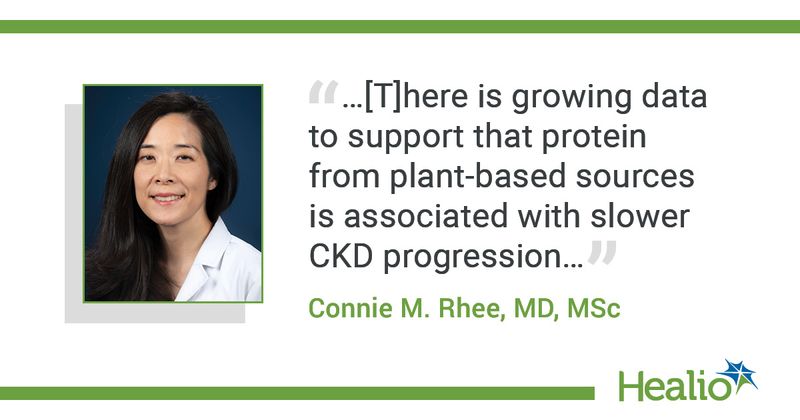Patients with ESKD under conservative care can benefit from a customized nutrition plan
Click Here to Manage Email Alerts
Key takeaways:
- Developing a nutrition plan for patients choosing conservative care, or no dialysis, can be beneficial.
- A plant-dominant low-protein diet can help a patient cope with uremic symptoms.
Individualized nutrition plans can boost quality of life and improve diet adherence for patients with kidney disease who choose not to undergo dialysis, a review of studies and guidelines published in the Journal of Renal Nutrition showed.
Evidence also suggests that low-protein diets, particularly those dominated by plant-based protein sources, can reduce the progression of chronic kidney disease and its complications.

“The updated 2020 [Kidney Disease Outcomes Quality Initiative] KDOQI nutrition guidelines for CKD recommend lower [dietary protein intake] DPI in adults with stages 3-5 CKD without diabetes in order to reduce the risk of [end-stage kidney disease] ESKD and death (based on grade 1A evidence),” Connie M. Rhee, MD, MSc, an associate professor of medicine and public health in the division of nephrology, hypertension and kidney transplantation at the University of California, Irvine, and lead author on the review, told Healio. “[The guidelines] also advise lower DPI in adults with stages 3-5 CKD with diabetes (based on opinion level evidence),” Rhee said.
“While we need further research on the specific effects of plant-dominant low-protein diets on CKD outcomes, there is growing data to support that protein from plant-based sources is associated with slower CKD progression and reduction in CKD-associated complications (metabolic acidosis, hyperphosphatemia) and CKD risk factors. Hence, pairing greater plant-based protein intake with low-protein diets (the latter of which there is solid evidence for improving CKD outcomes), may be particularly beneficial,” Rhee said.
Rhee and colleagues cited a trial of patients with diabetic kidney disease showing a mostly plant protein diet reduced complications compared with a diet of mostly animal protein. A second trial, involving patients who did not have diabetes and had non-dialysis dependent-CKD (NDD-CKD), found that a very low -protein diet was nutritionally safe and led to deferred initiation of dialysis, according to the review.
The researchers highlighted studies showing that flexible, multiple-choice nutrition plans yield better adherence, dietary satisfaction and quality of life in patients with CKD.
Diet has “an important role” to play in the conservative management of kidney function, Rhee and colleagues wrote. A patient-centered approach should involve “effective communication to alleviate anxieties around food or food misconceptions, individualized advice and assistance with implementation of dietetic advice in the face of a large symptom burden,” they wrote.
Customizability appears to promote adherence to diet plans in NDD-CKD, a finding backed up by “several innovative clinical models,” the authors wrote. In one such study, patients with severe or rapidly progressive NDD-CKD were offered three different options for a low-protein diet. “Excellent adherence was observed” across all arms, Rhee and colleagues wrote, “without observed differences in mortality or timing of dialysis initiation.”
The review noted that an “essential role” for kidney dietitians in providing individualized medical nutritional therapy, along with routine nutritional assessments, is recognized in recommendations from the International Society of Renal Nutrition and Metabolism and KDOQI. Protein source is also important, the researchers noted, citing four observational studies associating non-animal protein intake with less prevalent CKD, lower mortality risk or a lesser decline in eGFR.
